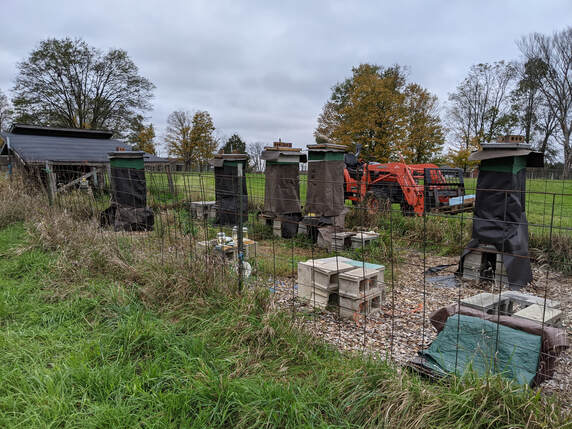 Absent? One of the most common problems beekeepers think they face is a colony that is queenless. I say “think” because sometimes a seemingly queenless colony isn’t actually queenless. Just understanding the biology behind a queen’s development will help determine if a hive is truly queenless. First, let me say that you don’t always have to see your queen when inspecting a hive. If you spot eggs (single eggs laid in the middle of the bottom of a worker-sized wax cell), then you had a queen in that hive at least 3 days ago. Similarly, if you see small, C-shaped larvae, then your hive had a queen at least 6 days ago. If you only spot big, fat larvae or capped brood cells, depending on the time of year (you may not see eggs in the fall), you may have a queen issue. Also, multiple eggs in cells or eggs laid on walls of the cells or drone brood sticking out of worker-sized cells may be an indication of a laying worker hive that has been queenless for at least 6 weeks. Brief The development cycle of a queen from an egg to an adult is the quickest of all the honey bee castes, lasting only 15-16 days. An egg is an egg for 3 days, then hatches into a larva. A larva that will develop into a queen is fed only royal jelly by the nurse bees and is a larva for 6 days. On the 9th day, the cell of a queen, much larger than that of a worker or drone (looks like a peanut hanging off the side or bottom of the frame), is capped. Inside the capped cell, the queen pupates rapidly, emerging (eclosing) from the cell as an adult on day 15 or 16. Cells of queens that have successfully emerged have little, round hatches at the bottom of the cell. Cells of queens that have been killed by other, faster eclosing queens or that have not successfully developed and whose cells were dismantled by the worker bees have oblong holes on the side of the cell. Closure (E-) Right after eclosure, a queen is what is called a virgin queen. She has not mated with any drones and therefore cannot lay fertilized eggs. Before she can go on one or more mating flights, however, she must orientate herself in the hive for about a week and allow her reproductive organs to mature. Her mating flights will be taken in the next 1-2 weeks (weather depending), and then she will typically require close to an additional week to start laying fertilized eggs. All up, from the time a queen ecloses to when she lays her first egg can be up to a month! That doesn’t include the just over 2 weeks from egg to eclosure. Patience is key when allowing a hive to make a new queen from an egg or young larva. More Information: https://extension.psu.edu/an-introduction-to-queen-honey-bee-development
3 Comments
 Advance Preparing a hive for winter starts in July with ensuring your bees are healthy (i.e. Varroa mite levels are under control), have ample resources (i.e. honey stores) to last them through the winter, and are queenright and strong (i.e. much easier to for 1 strong, large hive to survive winter than 2 small, weak hives). This means that you may have to feed your hives 2:1 sugar syrup (2 parts sugar to 1 part water) to bulk up their honey stores, and combine weak hives (particularly ones that are queenless, with queenright hives). Many beekeepers will typically also add a windbreak to their apiary in the winter. Common windbreaks include tarps, hay bales, and burlap. Bluster In addition to preparing your bees for winter, many beekeepers in colder climates also choose to prepare their hives for winter to help their bees survive the cold, resourceless months. There are two schools of thought when it comes to this hive preparation: ventilation and insulation. If a beekeeper keeps bees in typical, thin-walled Langstroth hive boxes with an inner cover and telescoping outer cover, and does nothing to prepare the hive structure for winter, they may have moisture problems in the hive. The bees form a cluster during the winter which they keep warm by flexing their wing muscles. Heat and water vapor are generated in this process and will rise to the top of the hive where they will condense on the cold inner and outer covers. The water will then rain down on and chill the bees. Condensation Proponents of ventilating a hive solve this problem by adding a quilt box on top of the hive (under the covers) to trap moisture and an upper entrance to allow air flow to remove the moisture from the top of the hive. They also typically wrap their hives in thin, black tar paper (i.e. roofing felt) to take advantage of the rays of the winter sun to “heat” the hive. Advocates of insulating a hive in the winter argue that upper ventilation lets out all of the heat because in addition to water vapor, heat also rises. They prefer to not have a quilt box or upper entrance and instead wrap their hives in thick foam board wrapped in black plastic and especially add insulation to the top of their hives to prevent the condensation of water vapor over the bee cluster. More Information: Winter Preparation Bees: www.honeybeesuite.com/how-to-prepare-your-hives-for-winter/ Ventilation: https://www.honeybeesuite.com/how-to-wrap-a-hive/ Insulation: https://www.beeculture.com/winter-management/ |
AuthorJen Haeger is a new master beekeeper and board member of A2B2. Archives
August 2022
Categories
All
|


 RSS Feed
RSS Feed
